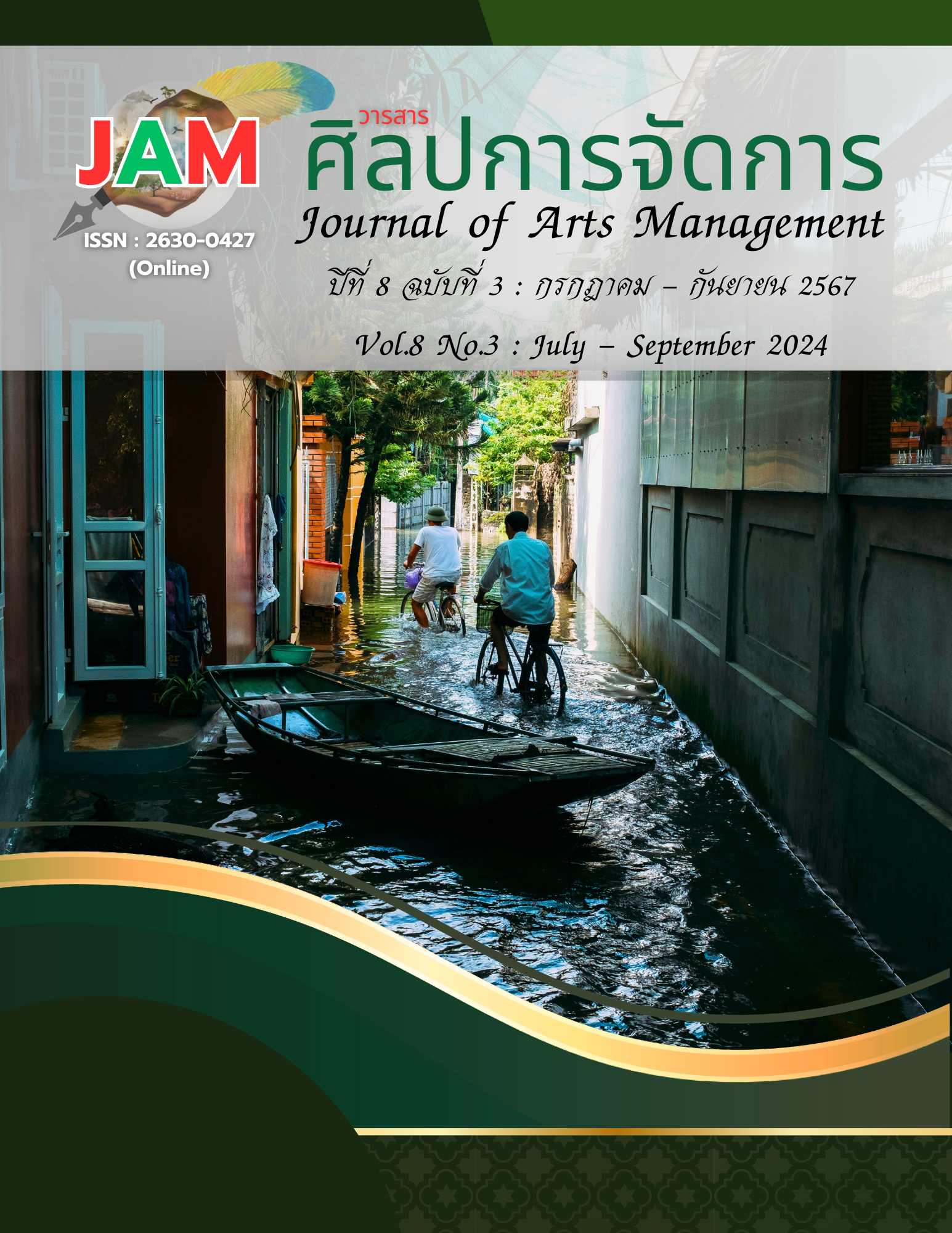Perceptions of Health Media Produced by Agencies Under the Ministry of Public Health
Main Article Content
Abstract
This research has the following objectives: 1) to study the perception of health media produced by agencies under the Ministry of Public Health, and 2) to study the demand for health media produced by these agencies. This is a quantitative research study. The population includes Thai citizens aged 19-80 years, registered in households in Bangkok, totaling 4,269,510 individuals as of 2022. A sample of 400 people was selected using the Taro Yamane formula and random sampling. The research tool was a questionnaire, and the collected data were analyzed using descriptive statistics, including percentages, means, and standard deviations.
Research results : The research found that the highest recognition of health media produced by the Ministry of Public Health was for the Department of Disease Control, at 24.0%.The most common channel for this recognition was Facebook, at 19.4%. The most frequently seen type of health media was infographics, at 65.0%. Infographics also had the highest content comprehension, at 69.1%. The demand for health media was rated high in terms of usefulness and reliability, with an average score of ( = 4.47).
Conclusion: Health media accessed through Facebook are convenient and fast, providing information that can be accessed anytime and anywhere. Infographics are particularly effective due to their concise and straightforward content, which can be understood quickly. There is a strong demand for health media that is accurate, reliable, and practical, enhancing awareness and applicability among the target audience.
Article Details

This work is licensed under a Creative Commons Attribution-NonCommercial-NoDerivatives 4.0 International License.
Views and opinions appearing in articles in the Journal of Arts of Management It is the responsibility of the author of the article. and does not constitute the view and responsibility of the editorial team I agree that the article is copyright of the Arts and Management Journal.
References
Chansawang, W. (2005). Health communication: Strategies in health education and health promotion. Charoendee Kanpim.
Department of Disease Control, Ministry of Public Health. (2020). Report on the situation of NCDs, diabetes, high blood pressure. and related risk factors 2019. https://ddc.moph.go.th/uploads/publish/1035820201005073556.pdf
Department of Disease Control, Ministry of Public Health. (2022). Number and death rate from 5 non-communicable diseases in 2017-2021. https://www.ddc.moph.go.th/dncd/news.php?news=39911
Electronic Transactions Development Agency, Ministry of Digital Economy and Society. (2020). Thailand Internet User Behavior 2020. https://www.etda.or.th/th/Useful-Resource/publications/Thailand-Internet-User-Behavior-2020.aspx
Gasemsarskoon, P., & Hongsam, B., & Saksawat, K. (2020). The use digital media to promote health. Journal of Humanities and Social Sciences, Khon Kaen University, 37(3), 162-182. https://so01.tci-thaijo.org/index.php/HUSO/article/view/243513
Health Literacy Promotion and Communication Division, Ministry of Public Health. (2019, 26 June). Chronic non-communicable diseases. https://multimedia.anamai.moph.go.th/associates/hp-ebook_14/
Health Literacy and Communication Promotion Division, Ministry of Public Health. (2020, October 19). Announcing a communication policy to create health literacy through social media. Fiscal year 2020. https://borc.anamai.moph.go.th/web-upload/
Health Literacy and Communication Promotion Division, Ministry of Public Health. (2023). Health media. https://multimedia.anamai.moph.go.th/
Klapper, J. T. (1960). The effects of mass communication. Free Press.
Likert, R. (1961). New patterns of management. McGraw–Hill.
McCombs, M. E., & Becker, L.B. (1979). Using mass communication theory. Prentice-Hall.
National Statistical Office, Ministry of Digital Economy and Society Thailand. (2023). The labor force survey whole Kingdom quarter 1: January - March 2023. https://www.nso.go.th/nsoweb/storage/survey_detail/2023/20230627133332_61156.pdf
Nawong, S., & Ekpanyakul, S. (2021) Expectation, exposure and satisfaction toward information on the government public relations department region 5’s Facebook Fanpage during the outbreak of novel coronavirus (COVID-19). Media and Communication Inquiry, 3(1), 1-16. https://so07.tci-thaijo.org/index.php/MCI/article/view/741
Ministry of Public Health. (2013, 1 June). Agency website. https://www.moph.go.th/index.php/about
Official Statistics Registration Systems. (2022). Registration official statistics system. https://stat.bora.dopa.go.th/stat/statnew
Rakbamnet, C. (2017). Academic report of the Parliamentary Budget Office, No. 7/2017, Budget burden for the health service system. Parliamentary Budget Office of the Secretariat of the House of Representatives. https://dl.parliament.go.th/handle/20.500.13072/547294
Rawinit, W., & Tepjak, P. (2021). Exposure to media about COVID-19 from the department of disease control and audience’s fake news literacy. In RSU National Research Conference 2021 on Social Science and Humanity, Education, Management, and Arts, (pp.313-323). https://rsucon.rsu.ac.th/proceeding/16
Ruchirat, K. (2018). News exposure behavior. and the use of Facebook page followers Ejan[Master’s thesis, Ramkhamhaeng University].
Saenchaisuriya, P., Theptian, B., Chanjarat, P., Prakongsai, P., Patchanee, K., & Trakulwong, P. (2019). Report of study results. Project to review the situation and results of operations to prevent and control chronic non-communicable diseases in Thailand, B.E. 2017 - 2019. Presented to the Division of Noncommunicable Diseases, Department of Disease Control, Ministry of Public Health. https://ddc.moph.go.th/uploads/publish/1036320200810073233.pdf
Spokesperson's Office, Secretariat of the Prime Minister. (2017). Thailand 4.0 drives the future towards stability, prosperity and sustainability. Thai Khu Fa Journal, 33, 1-44.
Strategy and Planning Division Office of the Permanent Secretary, Ministry of Public Health. (2022). Public health statistics 2022. https://spd.moph.go.th/wpcontent/uploads/2023/11/Hstatistic65.pdf
Thanasomboonkit, P., & Kaewboonruang, S., & Chue-ngam, P. (2008). Health communication (2nd ed.). Public Health Communication System Research and Development Plan (PHC).
Wong-arsa, O. (2020). The relationship between media exposure and health behavior to prevent particulate matter pm 2.5 of people in Bangkok[Master’s thesis, Chulalongkorn University].
World Health Organization, Thailand. (2017). Strategy for cooperation between the Thai government and the World Health Organization 2017-2021. https://iris.who.int/bitstream/handle/10665/255510/9789746804295-tha.pdf?sequence=5&isAllowed=y
Yamane, T. (1973). Statistics: An introductory analysis (3rd ed.). Harper and Row.


